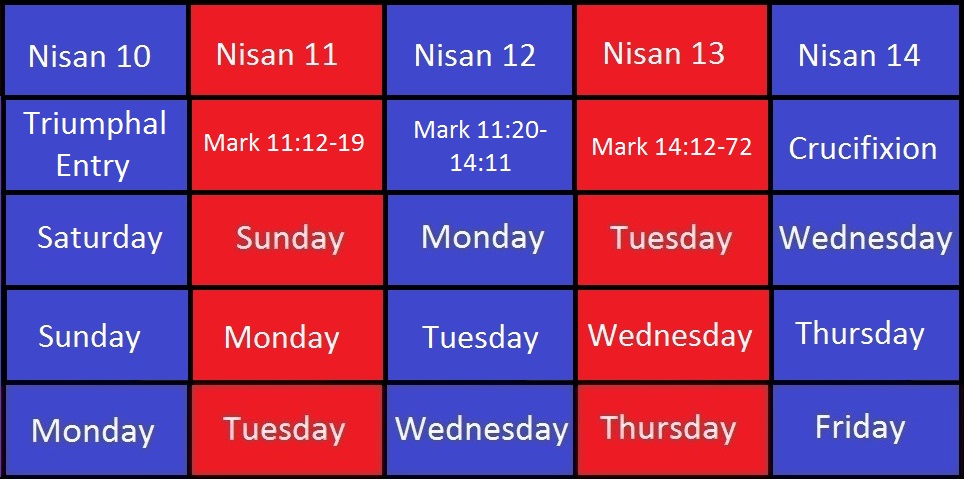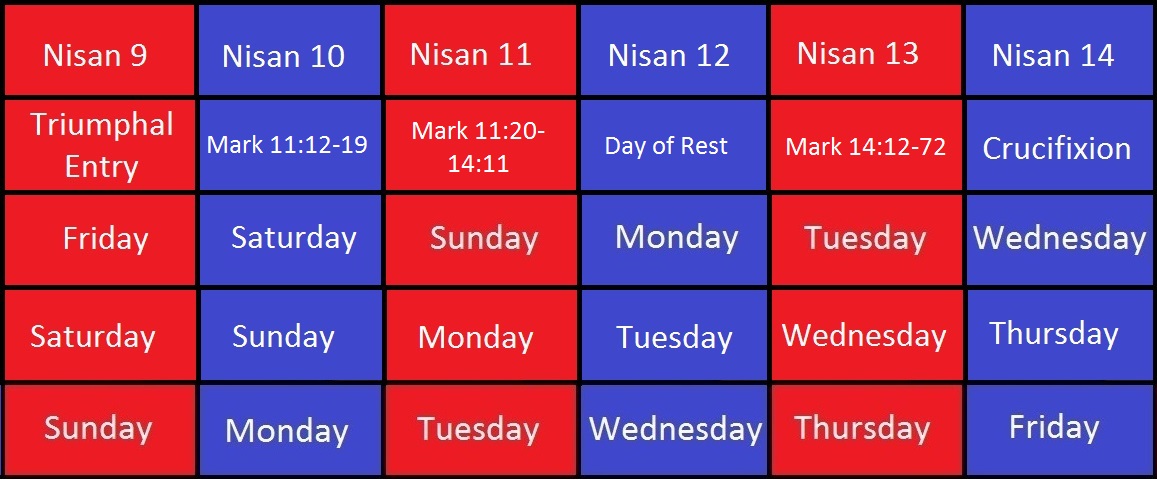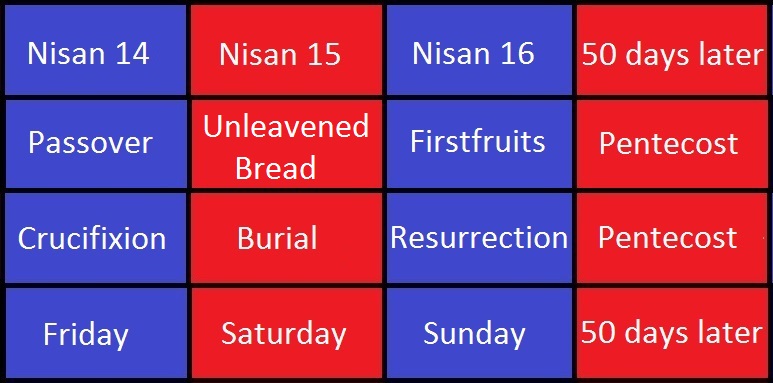The Day Jesus Died
For centuries the church has celebrated Good Friday as the day on which Jesus hung on Calvary's cross and paid for our sins with His blood. But some people believe that Good Friday should actually be Good Thursday or Good Wednesday. Determining a chronology of the events of the "Passion Week" is not necessarily an easy thing to do. And practically every chronology creates some questions that are not easily answered, if they can be answered at all.
To begin, one of the problems that we experience in determining the day that Jesus died is an incongruence of understanding of the biblical accounting of days and our accounting of days. We reckon a day to begin at midnight and end 24 hours later. Biblical days began at sunset and ended 24 hours later. The consequence this brings is seen in how we recognize certain days. For example, the Sabbath, the 7th day of the week, is generally stated as Saturday. Biblically though, the Sabbath is from sunset Friday to sunset Saturday. 
Scripture is clear in its declaration the the resurrection of Jesus took place on the first day of the week and before sunrise (John 20:1). Plotting this time on the chart would mean that the resurrection occurred at any time in the gray-shaded area. 
While we celebrate the resurrection on a Sunday, in reality, it could have actually occurred on our Saturday night. However, it seems probable to me that the rolling away of the stone from the door of the tomb happened not too long before the women arrived. Having said that though, we must remember that the rolling away of the stone was not for the purpose of letting Jesus out of the tomb, but to let the women come into it.
Mark's gospel declares that Jesus cried out with a loud voice at the ninth hour of the day. This would be at 3:00 in the afternoon. It was then that he "gave up the ghost" and died. His death then, would be 3 to 4 hours before sunset. Plotting these on the chart gives us the following: 
A verse that creates confusion as to the day of Jesus' death is Matthew 12:40 which states that Jesus would parallel Jonah by being in the heart of the earth for three days and three nights. If you understand this to mean there must be 3 twelve-hour periods of day and 3 twelve-hour periods of night, then only a Wednesday crucifixion is possible. 
If you count that any part of a 12-hour period constitutes the fulfillment of a day or a night, then a Thursday crucifixion is possible. 
If you understand the term "day and night" as an idiom for a 24-hour period and that any part of a day or night fulfills the requirement for a whole day, then a Friday crucifixion is possible. 
Linguistically, all three understandings of 3 days and nights are possible. One problem though, of the literal 72-hour period of time is that if something less than a 12-hour period of either day or night does not fulfill the declaration of Jesus, then neither would a more than 72-hour period of time fulfill His declaration. This would mean that Jesus must have been resurrected exactly 72 hours after he died, around 3:00 in the afternoon on Saturday, which obviously is not the case. The possible solution to this problem is found in Matthew 27:63 which states, "... Sir, we remember that that deceiver said, while he was yet alive, After three days I will rise again." The key word here is "after" which would then allow a Sunday resurrection. There is a significant problem however, with this "solution." There is only one place where it is recorded that Jesus said "after three days" and that is in Mark 8:31. The context seems to indicate that Jesus was alone with the apostles and therefore the man who claimed to hear Jesus' statement would not have heard Jesus say this at all and was lying. It is possible that Jesus may have said this on some other occasion that was not recorded in Scripture, but that is only speculative. Both Matthew and Luke, in recording the same event, state that Jesus said, "...be raised the third day." The Greek text for both Matthew and Luke does not include a preposition and simply puts "the third day" in the locative case. Greek experts, Dana & Mantey write that the locative case is a case that expresses, "a point within limits."1 Both Matthew and Luke then record that Jesus stated He would be raised within the limits of the third day. Mark's gospel does use the preposition meta (meta), which when used with a substantive in the accusative case (as it is in Mark's gospel) can rightly be translated as "after." However, Dana and Mantey state that the root meaning of meta is "within."2
The translational controversy is settled by the testimony of the Emmasus Road disciples. While on their journey from Jerusalem to Emmaus they were approached by Jesus, although they did not recognize Him. Jesus asked them what they had been talking about and they began to tell Him of the crucifixion. And then they said, "But we trusted that it had been he which should have redeemed Israel: and beside all this, to day is the third day since these things were done." (Luke 24:31) If Wednesday was the day of the crufiction and it was not being counted as one of the three days, then day #1 would be from sunset Wednesday to sunset Thursday, day #2 from sunset Thursday to sunset Friday and day #3 from sunset Friday to Sunset Saturday. According to the disciple this was the third day since the crucifixion and it was Sunday. Therefore, a Wednesday crucifixion seems to be impossible.
Another means of finding the day of the crucifixion is by looking at its relationship to the other events of the week. Mark's gospel sets out in detail the events of the week according to the days on which they occured. According to Mark's chronology of events, the day of the Triumphal Entry was followed by the day encompassed in Mark 11:12-19. The following day is described in Mark 11:20-14:11 and the day before the crucifixion is detailed in Mark 14:12-72. If you compare this chronology to the days given in Exodus 13 for the Passover observance you will find that the day of the triumphal entry was also the day that Israel would be selecting lambs for the Passover. (Nisan is the name of the first month on the Jewish calendar) This might very well explain why, when Jesus came into the Temple, that all He did was look around. It would be the next day that He would cleanse the Temple of the sellers and money changers. (Mark 11:11, 15)

By adding the day of the crucifixion to this chart we find that the Triumphal Entry occurred on a Monday if the crucifixion was on Friday, a Thursday crucifixion yields a Sunday entry, and a Wednesday crucifixion yields a Saturday Messianic presentation.
This creates a problem for a Wednesday crucifixion. In riding into the city on a donkey, Jesus would have violated the Mosaic Law which said, "But the seventh day is the Sabbath of the LORD thy God: in it thou shalt not do any work, thou, nor thy son, nor thy daughter, nor thy manservant, nor thy maidservant, nor thine ox, nor thine ass, nor any of thy cattle, nor thy stranger that is within thy gates; that thy manservant and thy maidservant may rest as well as thou.” (Deuteronomy 5:14) In the same manner, the cutting down of palm branches would also have violated the law (Numbers 15:32-36). In that the Pharisees were very particular about observing Sabbath regulations, had Jesus violated these laws, they would have been quick to be critical of Him. In that they said nothing, the only conclusion can be is that this did not occur on the Sabbath day.
This also means that if Friday was the day of the crucifixion, then Palm Sunday was in reality, Palm Monday. In order to correct this, some Bible students have suggested that there is a day in the week where Jesus and the disciples remained in Bethany. It was a day of rest, probably occurring between Mark 14:11 and 14:12. Since nothing notable would have happened on that day, nothing would be recorded in the Passion Week accounts. This solves the problem of Palm Sunday for a Friday crucifixion and also the problem of violating the Mosaic Law for a Wednesday crucifixion. It does though, create a problem for a Thursday crucifixion and the Mosaic Law violation. 
One final area that can be examined to determine the day of Jesus' crucifixion is in the feast days of Israel subsequent to Passover. Leviticus 23:5 states that Passover is to be observed on Nisan 14. Leviticus 23:6 states that the following day began the feast of Unleavened Bread. This observance was to last for seven days (Nisan 15-21). The first day of this feast would be a Sabbath day regardless of on what day of the week it occured. According to Leviticus 23:11-14, the following day would be the observance of the Feast of Firstfruits. Then fifty days after Firstfruits they would celebrate the Feast of Pentecost. Jesus was identified by John the Baptist as the Lamb of God which takes away the sin of the world (John 1:29) and the Apostle Paul declared that He was our Passover (1 Corinthians 5:7). As such, He became the antitype of the Passover Feast. Paul aslo identified Jesus as the firstfruits from the dead (1 Corinthians 15:23) and so is the antitype of the Feast of Firstfruits. Jesus' promise of sending the Spirit was fulfilled on the day of Pentecost and consequently He became the antitype of that feast day. In that the Pentecost of Acts 2 came exactly fifty days after the resurrection of Jesus Christ, would it not be probable, if not absolutely necessary, that the other typical days be fulfilled in a precise chronological progression? Therefore, it seems as if there is only one scenario that fits the typology

At the end of the day, two critical conclusions must be drawn from this study. First, while I tend to believe that we observe Good Friday and Palm Sunday correctly, but I also tend to believe that Palm Sunday may have been Palm Monday. The insertion of a day in the Passion Week, when Mark seems to otherwise be specific in his recounting of events, creates some uncertainly in my mind. But having said that, it is not as important on what day we celebrate these historic events as why we celebrate these historic events. One's possession of salvation is not dependent on believing a gospel message that Jesus died on Friday and rose again on Sunday, but that He died and rose again. While digging into the biblical data that may declare the day of the week on which Jesus died should fascinate us and cause to to study intently, it should not divide our fellowship. Second, I have sought to compare and analyze all the biblical data concerning the issue and draw a conclusion. I may have gotten it correctly, or I may have been mistaken. In time, if I have opportunity to consider the subject again, I may need to refine what I have put in print. However, this I do know with absolute certainty. God in His infinite wisdom accomplished all this PERFECTLY, and it is recorded by inspiration PERFECTLY.
ENDNOTES
1 Dana, H.E. & Mantey, Julius R., A Manual Grammar of the Greek New Testament, (New YorK: MacMillan Publishing Co., 1955) p. 86.
2 Ibid., p. 107.